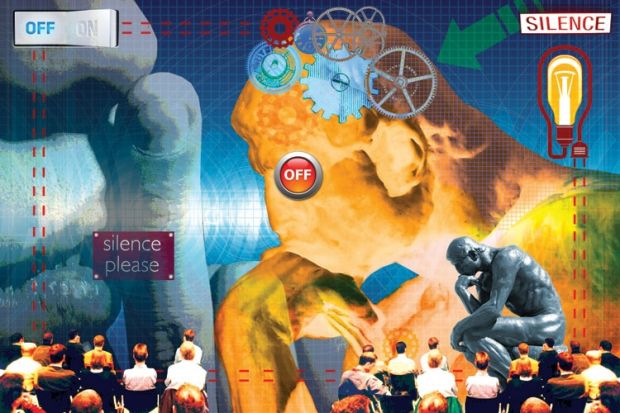Source: Miles Cole
If a pause follows one of my questions, I answer it myself; when I urge my students to ‘think about it!’, I proceed to think about it (aloud) for them
Driving to campus one day last month, I turned on the car radio – as unthinking a gesture as flipping on the air conditioning in summertime Houston. But as the last movement of Mozart’s Jupiter symphony sounded from the speakers, I again punched the button. My reluctance to listen yet again to a hallowed piece of music hollowed out by endless repetition had overridden my resistance to (relative) silence.
And then the thought occurred to me: had I myself become the equivalent of a radio in the classroom? When I confront my students, do I reflexively punch the on button to my professorial self? Is it better to fill the room with the noise of lecturing than to challenge anyone with silence? Are there not moments when, as in the car, I should punch the off button?
Apart from suggestions for keeping unruly students quiet, there seems to be little research into the pedagogical uses of silence, yet almost everyone but teachers seems to be talking about it. In her best-selling Quiet: The Power of Introverts in a World That Can’t Stop Talking (2012), Susan Cain quietly praises it, while George Prochnik, in his Pursuit of Silence: Listening for Meaning in a World of Noise (2011), chases after it in Trappist monasteries and scientific laboratories. In the wake of interviews with deaf students and faculty at Gallaudet University in Washington DC, he suggests that silence allows us to see the world, both literally and metaphorically, in new ways.
When I step into a classroom, my students stop their habitual multitasking and fall silent. But it feels like the aural equivalent of the Dead Sea. No life here, I tell myself: no depths to plumb. Hence I banter desperately with them as I take the register. And when I segue to my lecture, the words continue flowing. If a pause follows one of my questions, I answer it myself; when I reach a critical moment and urge my students to “think about it!”, I proceed to think about it (aloud) for them.
All of this reflects badly on me as a teacher, but it also reflects a general professorial anxiety regarding silent students. It is rather like when, upon hearing a suspicious clanking in the engine, we turn up the radio’s volume to drown it out.
Of course, there might be mechanical difficulties behind the hooded gaze of the student, such as ignorance or indifference, diffidence or doubt. But the workings of reflection and thought also need time to surface.
A pianist once told me that anyone can play notes, but only musicians can play the silences in-between. Indeed, Stanford University researchers have discovered that the brain’s activity intensifies rather than diminishes in the silences between notes. Sated with what they just heard and elated at the prospect of what is to follow, the parts of our brain responsible for memory and language light up like the night sky over the Arctic.
But there is important fine print to this experiment: the specific piece of music it used, by Baroque composer William Boyce, was new to the listeners. The effort at anticipation, impossible with Mozart’s 41st, for example, was pivotal – quite literally.
Whether they are monologues or instances of call and response, the scripts of most history lectures are as familiar to students as the melodic and chromatic elements of Mozart’s old warhorse are to me. But might it be possible to create similar moments of micro-meditation by shaking up those scripts and deliberately making room in them for pauses – such as between asking a question and seeking an answer?
I’m not talking about dramatic pauses – the stuff of academic theatrics. I mean sustained and, eventually, sustaining pauses. Pauses that allow us to concentrate: to turn inward and draw upon our own resources in attending to the question (don’t forget that the French verb attendre also means “to wait”).
In his celebrated composition 4´33˝, first performed in 1952, American avant-garde composer John Cage made us hear that what passes for silence isn’t. The musical silence that follows the pianist’s appearance invites the audience to hear not just their world – the sigh of the wind and of their neighbours – but also their thoughts about what makes for music. In an interview several years later, Cage said: “No day goes by when I do not make use of that piece in my life and my work.”
What if, just one day for starters, I improvised a lecture piece titled 2´11˝ or 1´46˝? What if I were to ask a question, and then sit down at my desk in studied silence? Would my students be outraged, as some members of Cage’s early audiences were, and demand their tuition fees back? Or would others bump into new thoughts not just about history but also their own selves? And would this better prepare them to bump into other selves: be they historical actors, fictional characters or our fellow men and women?
Sigh.




